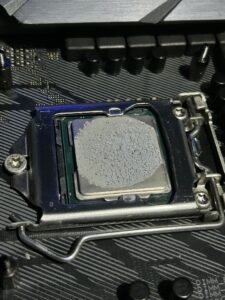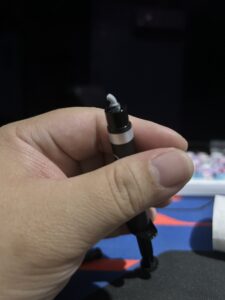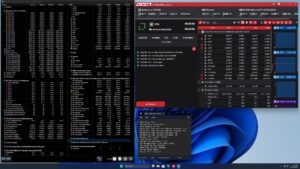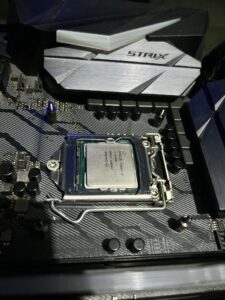Good news from client ! A huge thank you to our wonderful friend for not only testing our thermal grease but also writing this fantastic blog post about their experience!
We're so proud that our sample delivered outstanding performance in their rigorous tests. It's proof that our products compete at the high global level.
https://www.techpowerup.com/forums/threads/the-official-thermal-interface-material-thread.278074/page-75
Cayom CA-3 Review
The Paste and the Test Bench
So I started this week poking around with the samples sent by Cayom, for me to try out, I went straight with their flagship as Katrina(one who's handling my requests) was very eager for me to try that one out, it didn't disappoint, this paste has no bells or whistles and is straight on with its capabilities, the CA-3 Ultimate is advertised to have a thermal resistance 0.025C/watt and an advertised 8w/mk thermal conductivity was used on a test bench with a picky Intel i7 9700K with the Corsair H115i 280mm AIO Cooler in a 25c maintained ambient temperature room, and the fans on the AIO will be running on its max RPM as well as the pump for consistent results.
From the get go, others might simply think its just a measly paste with that spec, but mind you, the material is thick (and I love it!!), and is easy to apply with the tool included in its package, the initial press gave a solid pattern on both the IHS of the processor and on the cold plate of the AIO, the application is also not wet, like some other thermal interface material, the thickness and richness of the paste is very advantageous on filling those micro cracks and helps on uneven mounting pressure, it easily levels down and doesn't need any curing at all.
The Testing principle
Idle temps were very impressive, the core temperatures are 2-6c delta to the ambient temp, this gave me an idle core temperature of around 27-31c (as mentioned above, pump and fans are on maximum RPM), now I will be testing using a constant load cycle on the processor using y-cruncher VT3(AVX) and using OCCT(SSE), AVX as we all know generates more heat and would easily throttle down the processor severely when it reaches the TJ Max, I have set an AVX offset in the bios of -2 as this particular sample of the i7 9700K is temperamental and uses a lot of voltage (not the best bin around to test out for sure) and this will be the perfect sample to try this flagship paste from Cayom.
Results
Stress testing using y-cruncher VT3(AVX) yielded a delta core temp of 36c, in which for this particular sample and generation of processor is normal, which actually yielded a maximum package temp of 75c and a range between 67-75c on the core temps, maximum recorded TDP is 142w with a normalized/average load during the test of 109w, average core voltage during this run was 1.258v and the core VID's averaged around 1.306v per core at 4.7ghz, still a far cry from the max temp the processor can go at 100c, and the test ran for a duration of 84 minutes, next was the OCCT Stress test(SSE), the test was programmed to run in 20 minutes with the Extreme preset with variable load on all threads, this resulted in maximum delta of 41c over the ambient with package temps reaching 78c with a maximum 150.5w load which averaged/normalized around 128w with an effective cpu frequency of 4.8ghz, the recorded core voltage average was sitting at 1.22v and the VID average per core is around 1.276v up to 1.301v for the worst cores, on a normal use case like web browsing, office work, programming, and gaming, we wouldn't be even seeing this high on average, I was just seeing a maximum core and package temp at 59c and averages around 46-47c while gaming (2k resolution, still the pump and fans at max), pretty much not bad at all.
Long Term?? Other Thoughts??
For quite a few days I have been testing this prior to the post of this review and there were no degradation on temperatures from the same application used on the test, as well as there were no drying up nor cracking of the paste due to the stress it received while running the OCCT and Y-Cruncher test, it was still thick and temperatures are found to be normal, to be fair, this paste feels better than the MX6 and NT-H1 for comparison as the latter are more liquidy and I found them to dry up quicker when I tested them on my Arrow Lake setup (Ultra 9 285k) and my Zen5 Ryzens (9950X3D and a 9700X) the same thing happens on my Thermal Grizzly Kryonaut application, in just a few weeks, the temperatures start to creep up which is bad, I find it plausible like the Thermalright TFX and TF8 in the sense that it is thick and never cracks/dries up fast though the TFX is kinda funky to apply which the Cayom CA-3 makes up with, overall, the tests showed that Cayom CA-3, their flagship, is indeed competing with the known brands up there, not just in quality and performance but also the price (they do sell well in China from what I have heard), I still have a long way down emptying up the samples they sent me, but my spidey-sense tells me that this will be worth my time and yours probably as well, for those water cooling enthusiasts, this might be a game changer as I personally do not tinker much with my PC's once they're all tweaked and everything left alone, and that's why I want a TIM that wouldn't degrade temperatures fast and would easily dry up.





